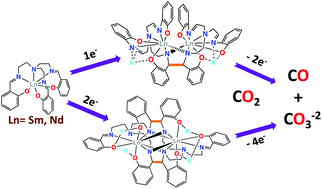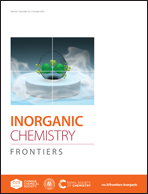Carbon dioxide reduction by lanthanide(iii) complexes supported by redox-active Schiff base ligands†
Abstract
Here we have explored the ability of Schiff bases to act as electron reservoirs and to enable the multi-electron reduction of small molecules by lanthanide complexes. We report the reductive chemistry of the Ln(III) complexes of the tripodal heptadentate Schiff base H3trensal (2,2′,2′′-tris(salicylideneimino)triethylamine), [LnIII(trensal)], 1-Ln (Ln = Sm, Nd, Eu). We show that the reduction of the [EuIII(trensal)] complex leads to the first example of a Eu(II) Schiff base complex [{K(μ-THF)(THF)2}2{EuII(trensal)}2], 3-Eu. In contrast the one- and two-electron reduction of the [NdIII(trensal)] and [SmIII(trensal)] leads to the intermolecular reductive coupling of the imino groups of the trensal ligand and to the formation of one and two C–C bonds leaving the metal center in the +3 oxidation state. The resulting one- and two electron reduced complexes [{K(THF)3}2Ln2(bis-trensal)], 2-Ln, and [{K(THF)3}2{K(THF)}2Ln2(cyclo-trensal)], 4-Ln (Ln = Sm, Nd) are able to effect the reductive disproportionation of carbon dioxide by transferring the electrons stored in the C–C bonds to CO2 to selectively afford carbonate and CO. The selectivity of the reaction contrasts with the formation of multiple CO2 reduction products previously reported for a U(IV)-trensal system.

- This article is part of the themed collection: Rare Earth Chemistry – In memory of Professor Xu Guangxian at his centenary


 Please wait while we load your content...
Please wait while we load your content...